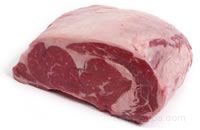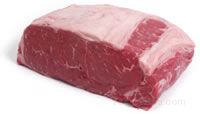Roat Beef Cook Time Per Pound
Roast beefiness has always been a favorite dinnertime entrée. A flavorful roast beef is non difficult to cook, simply there are a few of import considerations to remember to ensure a skilful result. The post-obit four points should be considered when you want to cook a delicious beef roast.
- The type of beef roast
- The size of the beef roast
- The beef roast cook times
- The roasting temperature
| Get-go, let's consider the type of beef cut to use for your roast. Since roasting is a dry rut cooking method, yous should use beefiness cuts that are tender and well marbled. Tougher beefiness cuts with less marbling tend to dry out much more quickly (although when the proper steps are followed, fantabulous results can be achieved). A beef roast cut from the rib or loin section is often the all-time pick; for instance, try a rib-eye roast if your goal is to serve a superlative quality roast with lots of flavor. The rib-eye roast refers to a rib roast in which the 6th through the 12th rib bones have been removed leaving just the rib-eye muscle. When the bones are not cut away from this roast, information technology is known as a continuing rib roast. Both of these roasts are ones that yous probably wouldn't cook with whatsoever frequency, because both are quite expensive, only the tenderness and flavor of the rib-eye roast and the standing rib roast are tough to beat. | Rib-centre Roast |
|
| Top Loin Roast |
| Also plant in the short loin fundamental cut is the tenderloin, which is the within muscle of the short loin. It is the most expensive cut of beef and can be roasted whole or it can be cut into tender, boneless steaks. The tenderloin roast is as well known by the following names:
Both the elevation loin roast and the tenderloin roast are often cooked apace at loftier heat, which seals in the juices. Both beef roasts are ordinarily cooked to no more than medium doneness to ensure that the meat remains tender and moist. | Tenderloin Roast |
Of course, the size of the beefiness roast is very of import in determining the length of fourth dimension required to cook the roast. It is often easiest to melt a roast using a predetermined length of cook fourth dimension per pound. That fashion, you lot can cook whatsoever size beef roast by simply multiplying the cook time per pound by the number of pounds that the roast weighs.
The oven temperature used to cook a beef roast is normally set somewhere between 300 degrees and 450 degrees Fahrenheit. The recommended cooking temperature for your roast is unremarkably determined by the blazon of beef cut that you plan to roast. Some beef roasts are best when tedious roasted at lower temperatures, while other roasts are best when cooked quickly with high heat. At that place are even a few beef roasts, especially some of the tougher roasts from the circular or chuck, that are best when cooked with loftier heat at the start (to sear the outside of the meat and seal in the juices) and then cooked at a lower temperature to finish the roast.
The cook time and temperature are not but adamant past the type of beef roast but likewise past such considerations every bit the amount of marbling within the beefiness roast, the amount of outer fatty covering the roast, and whether or not the roast is boneless. And, because in that location are a number of considerations that make up one's mind the proper cook fourth dimension and temperature, a cooking times chart should be used only as a guideline and not as an absolute. The best method for determining the desired doneness of a beefiness roast is with the use of a reliable meat thermometer.
BEEF Cooking Times and Temperatures | |||||||
Oven Baked or Roasted Beef | |||||||
| Beef Cut | Oven Temperature | Weight (pounds) | Approximate Cooking Time (minutes per pound or as indicated) | ||||
| Rare (140°F) | Medium-rare (145°F) | Medium (160°F) | Medium-well (165°F) | Well Washed (170°F) | |||
| Continuing rib roast (Prime number Rib): | Roast at 450°F for xv min. and then finish at 325°F for times shown below | Rare (120 - 125°F) | Medium-rare (130 - 135°F) | | | | |
| | 325°F | vi-8 lbs. | i 1/iv - 1 i/2 hrs. | 1 ane/ii - 1 3/4 hrs. | | | |
| | 325°F | eight.5-x lbs. | 1 1/2 - ii hrs. | 1 3/four - 2 1/4 hrs. | | | |
| | 325°F | ten.v-thirteen lbs. | 2 - 2 i/2 hrs. | two i/4 - ii 3/four hrs. | | | |
| | 325°F | 14-16 lbs. | 2 1/two - iii hrs. | 3 - three one/two hrs. | | | |
| | 325°F | 16.5-eighteen lbs. | 3 - 3 1/2 hrs. | 3 i/2 - four hrs. | | | |
| Rib roast (chine bone removed) | 350°F | 4-vi lbs. | 1 1/4 - 1 3/four hrs. | 1 three/4 - 2 1/4 hrs. | 2 1/4 -2 3/four hrs. | 2 three/4 - 3 1/4 hrs. | iii 1/iv - 3 3/4 hrs. |
| 6-8 lbs. | i 3/4 - 2 one/4 hrs. | ii 1/4 - 2 three/4 hrs. | two 3/4 -three 1/four hrs. | 3 1/four - 3 3/four hrs. | 3 3/4 - 4 1/4 hrs. | ||
| Rib eye roast: | | | | | | | |
| | 350°F | 4-6 lbs. | i 1/2 - i iii/4 hrs. | 1 3/iv - ii hrs. | two - ii one/2 hrs. | 2 1/2 - iii hrs. | 3 - 3 1/2 hrs. |
| | 350°F | 4-6lbs. | ane 3/4 - 2 hrs. | 2 - 2 1/2 hrs. | 2 one/2 - 3 hrs. | 3 - iii ane/two hrs. | iii 1/ii - 4 hrs. |
| Eye circular roast | 325°F | 2-three lbs. | 1 1/4 - 1 1/2 hrs. | 1 1/2 - 1 3/four hrs. | 1 3/4 - 2 hrs. | 2 - 2 ane/4 hrs. | 2 1/iv - 2 iii/iv hrs. |
| Round tip roast | 325°F | 3-4 lbs. | 1 1/2 - 1 3/four hrs. | i three/four - 2 hrs. | ii - 2 one/2 hrs. | 2 1/2 - 3 hrs. | 3 - iii 1/2 hrs. |
| half dozen-viii lbs. | 2 ane/4 - two ane/2 hrs. | 2 ane/2 - 3 hrs. | three - iii 1/2 hrs. | 3 1/2 - 4 hrs. | 4 - 4 1/2 hrs. | ||
| Sirloin tip | 300-325°F | 3 one/2-iv lbs. | 35 min. | 36 min. | 38 min. | 39 min. | 40 min. |
| Rolled rib | 300-325°F | 5-7 lbs. | 32 min. | 35 min. | 38 min. | 43 min. | 48 min. |
| Rolled rump | 300-325°F | iv-six lbs. | 25 min. | 26 min. | 28 min. | 29 min. | 30 min. |
| Whole tenderloin | 425°F | 4-5 lbs. | 45-60 min. full | 50-lx min. total | 60-70 min. full | | |
| Half tenderloin | 425°F | 2-3 lbs. | | 35-40 min. full | 45-50 min. total | | |
| Meatloaf | 350°F | 1 one/ii lbs. | | | 75 min. total | | |
| Note: Beginning with meat at refrigerated temperature. Remove the meat from the oven when information technology reaches 5° to ten°F below the desired doneness; the temperature will go along to rising equally the meat stands. | |||||||
Recall, use the roast cook times in this chart as a guide merely. The oven temperatures and roast cook times listed here are accurate enough to provide y'all with adept results; all the same, it is important to keep in mind that a number of variables can brand a difference when using these guidelines to melt your roast. Y'all must consider the differences in ovens, whether or not the roast is placed into the oven directly from the refrigerator, the use of an oven cooking purse, and even the altitude of where y'all live—all of these tin change the cook times for a beef roast past a significant margin.
Note: See the article, "Beefiness Cooking Times," for boosted cook times and temperatures for a diverseness of other beef roasts, steaks, and basis products.
Source: https://www.recipetips.com/kitchen-tips/t--1542/roast-beef-cook-time.asp



0 Response to "Roat Beef Cook Time Per Pound"
Post a Comment